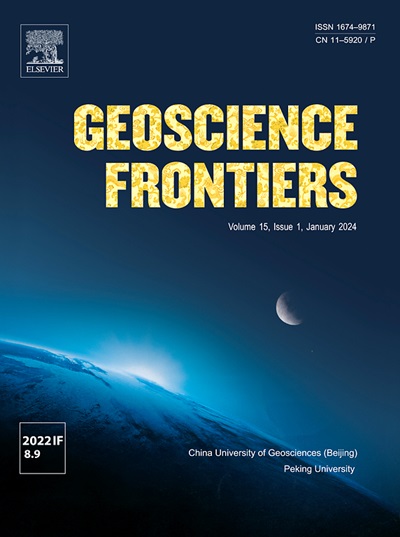水镁石在高压和高温下的稳定性和物理性质:对地球深水循环的启示
IF 8.9
1区 地球科学
Q1 GEOSCIENCES, MULTIDISCIPLINARY
引用次数: 0
摘要
水镁石是地球上常见的含水矿物,可能参与了地球的深水循环,但其在地幔条件下的稳定性和结构仍不确定。在这项研究中,我们研究了水镁石在800k下高达60gpa和在1850k下高达45gpa的稳定性。在实验P-T条件下,没有观察到理论预测的新相,水镁石保持在P3¯m1结构中。确定热EoS的水镁石和地幔矿物的弹性参数,我们建模的速度和密度轮廓在顶部下地幔俯冲含水方辉橄榄岩,假设水储存在水镁石和相位D建模的基础上,1 wt. %水将方辉橄榄岩的速度和密度减少和∼∼5%和2%,分别,但水是否存储在水镁石或D阶段弱影响密度和速度。当含水率达到2.4 wt.%时,含水辉石的密度比周围地幔低2.2(2)% ~ 2.8(2)%,但其VP和VS仍比正常地幔高0.3(1)% ~ 0.7(1)%和0.7(2)% ~ 1.8(2)%。因此,在地震观测中,低密度含水辉石虽然是一个高速体,但可能会减缓板块的俯冲。本文章由计算机程序翻译,如有差异,请以英文原文为准。

Stability and physical properties of brucite at high pressures and temperatures: Implication for Earth’s deep water cycle
Brucite is a common hydrous mineral on Earth and may contribute to the deep water cycle of the Earth, but its stability and structure under mantle conditions remain uncertain. In this study, we investigated the stability of brucite up to 60 GPa at 800 K and 45 GPa at 1850 K. Within the experiment P-T conditions, no theoretically predicted new phase was observed, and brucite remained in the Pm1 structure. With the determined thermal EoS of brucite and the elastic parameters of mantle minerals, we modeled the velocity and density profile of subducted hydrous harzburgite in the top lower mantle, assuming that the water was stored in brucite and phase D. Based on the modelling, 1 wt.% water will reduce the velocity and density of harzburgite by ∼ 5% and ∼ 2%, respectively, yet whether the water is stored in brucite or phase D has weak influence on both density and velocity. With a water content up to 2.4 wt.%, the density of hydrous harzburgite could be reduced to 2.2(2)%–2.8(2)% lower than the surrounding mantle, while the VP and VS of hydrous harzburgite are still 0.3(1)%–0.7(1)% and 0.7(2)%–1.8(2)% higher than that of the normal mantle. Thus, the low-density hydrous harzburgite may slow down the subducting of slab, despite being a high-velocity body in seismic observations.
求助全文
通过发布文献求助,成功后即可免费获取论文全文。
去求助
来源期刊

Geoscience frontiers
Earth and Planetary Sciences-General Earth and Planetary Sciences
CiteScore
17.80
自引率
3.40%
发文量
147
审稿时长
35 days
期刊介绍:
Geoscience Frontiers (GSF) is the Journal of China University of Geosciences (Beijing) and Peking University. It publishes peer-reviewed research articles and reviews in interdisciplinary fields of Earth and Planetary Sciences. GSF covers various research areas including petrology and geochemistry, lithospheric architecture and mantle dynamics, global tectonics, economic geology and fuel exploration, geophysics, stratigraphy and paleontology, environmental and engineering geology, astrogeology, and the nexus of resources-energy-emissions-climate under Sustainable Development Goals. The journal aims to bridge innovative, provocative, and challenging concepts and models in these fields, providing insights on correlations and evolution.
 求助内容:
求助内容: 应助结果提醒方式:
应助结果提醒方式:


